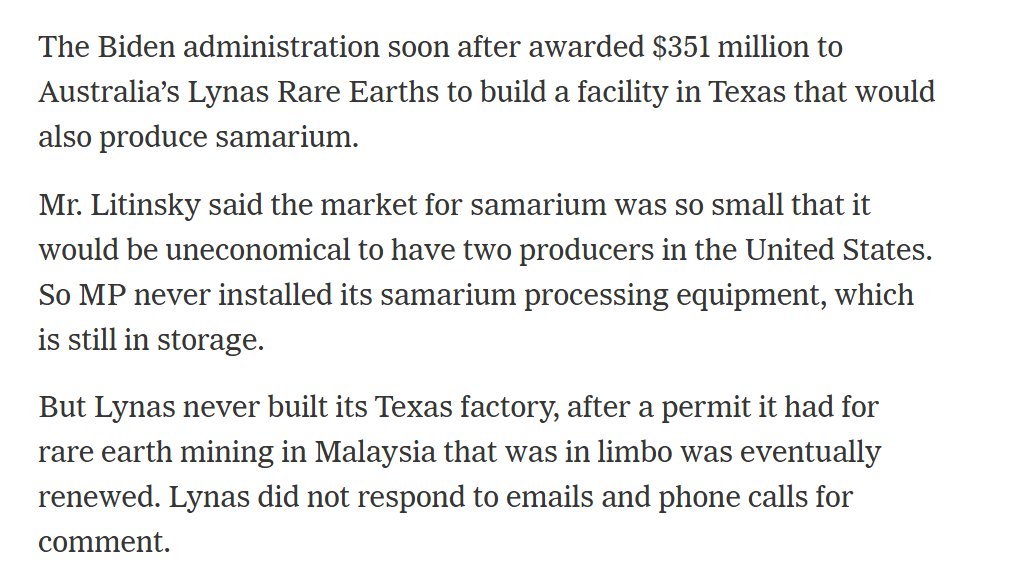Building out capacity (including refining capacity) for rare earths/ other critical minerals should indeed by a real priority now, and the risk of weaponization of this this and other supply chains should have been taken more seriously in the past. But it won't be easy
1/
1/
https://twitter.com/TonyNashNerd/status/1977036957109866501
Just as an example of how far the political debate has come -- Bob Lighthizer (no China dove) excluded rare earths and permanent magnets from the 301 tariffs back in 18 and 19 ...
3/
3/
Pharmaceuticals from China too (why raise the price of meds ... )
For rare earths and magnets there was essentially no US supply, so the tariffs just raised costs (absent a plant o build out capacity over time)
4/
For rare earths and magnets there was essentially no US supply, so the tariffs just raised costs (absent a plant o build out capacity over time)
4/
+ the US had won a WTO case against China's export controls on rare earths (controls that were were intended to encourage manufacturing of items using permanent magnets in China) and well, it viewed as bad form to tariff something that the US wanted to China to export freely 5/
Quaint concerns by today's standards, but it illustrates how far the debate has come. The Biden Administration did put in place tariffs on rare earth magnets (phased in) back in early 2024, but it was a bit of a fight (concerns about raising cost of green transition) 6/
The Biden Administration did a series of reports -- including a strong one on critical minerals/ rare earths - highlighting supply chain weakness that needed to be addressed post pandemic ...
7/
7/
But a lot more was done on semiconductors (The CHIPS act does appear to be working in the advanced nodes, tho not without some difficulties) and even other bits of clean tech (via DOE loans office) than on pharma and rare earths
8/
8/
And part of the problem was the hope that commercial firms, burned by the supply chain snarls of the pandemic, would do the investment largely on their own ...
9/
9/
That though ran into a problem -- rare earth prices tanked (rare earths aren't that rare and all, the bottleneck is refining and China actually has plenty of capacity)
10/
10/

"Analysts say these projects are at risk from price fluctuations because western efforts to support the sector remain piecemeal and flawed against China’s multi-decade lead"
11/
ft.com/content/37966c…
11/
ft.com/content/37966c…
Western firms looking for "super-returns" that keep up wit the tech cos (and the crypto marketing bros) aren't that keep on projects with very large upfront costs, and at best uncertain returns (China can always flood the market at the lowest price point ... )
12/
12/
There are solutions (the DoD is offering price guarantees) -- but they have a price tag.
The fundamental problem is that projects that provide economic security don't necessarily deliver a clear commercial return
13/
The fundamental problem is that projects that provide economic security don't necessarily deliver a clear commercial return
13/
The only big of good news -- for rare earths and for that matter active pharma ingredients/ key precursors -- is that the actual capital costs aren't huge. 10s of billions, may low 100s of billions would make a big difference (contrast with the AI buildout)
14/
14/
But in my view the needed approach requires serious sustained political commitment (I would say bipartisan commitment) and a willingness to recognize that commercial firms both have to be involved and that commercial incentives on their own aren't enough ...
15/15
15/15
And the key bits of open source material here almost all come from the great Keith Bradsher
nytimes.com/2025/10/09/bus…
nytimes.com/2025/10/09/bus…
and more - the samarium story should be more wildly known, as it points to real problems in the defense supply chain
nytimes.com/2025/06/09/bus…
nytimes.com/2025/06/09/bus…
• • •
Missing some Tweet in this thread? You can try to
force a refresh














